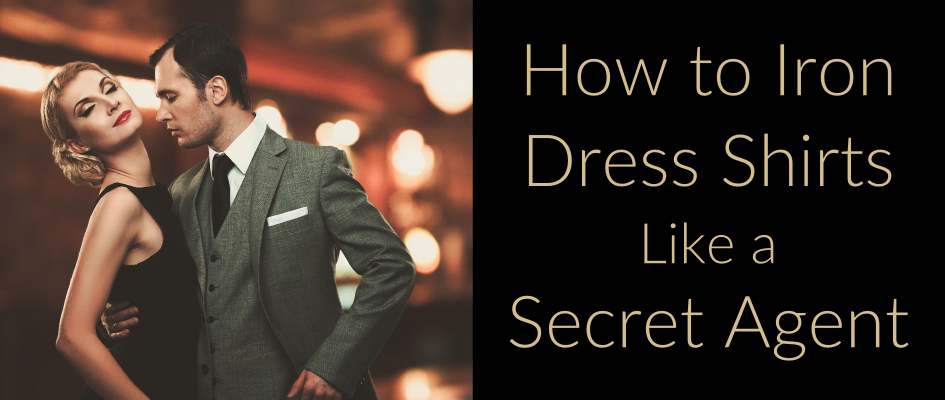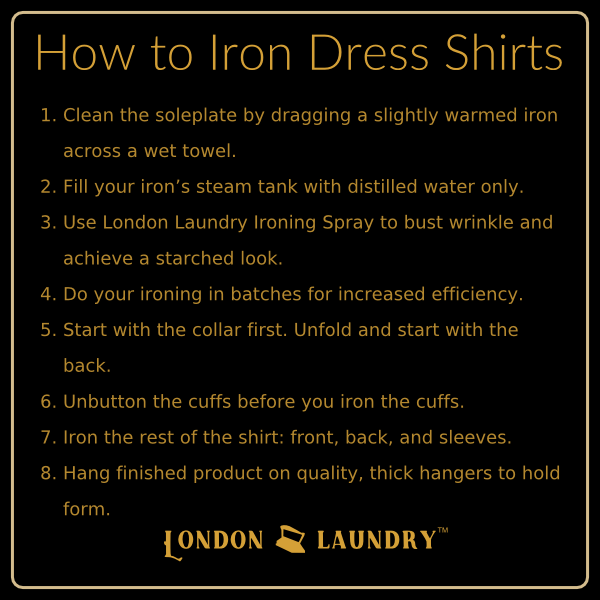How to Iron Dress Shirts Like a Secret Agent February 01 2019


How to Iron Dress Shirts Like a Secret Agent
These tools may set you back a little now, but think about all the time and money you will save on trips to the cleaners.
- A quality iron with a clean sole plate
- An ironing board with a tidy, smooth surface
- Clean water for the steamer; preferably distilled or filtered
- London Laundry Unscented Ironing Spray or spray bottle of distilled water for misting
- A damp towel for cleaning the sole plate
- Quality hangers for finished product

Equipment Counts
A word about quality is this: you pay a bit more up front, but you save loads of money on the back end. When other people are continually repairing, or altogether tossing their failed equipment, yours will still be operating to spec. Quality equipment stays together longer and delivers a consistently superior result as compared to cheap units. This does not imply that you must buy the most expensive unit on the market. Rest assured there are plenty of solid models available that won’t break your wallet.
All irons these days come with multiple temperature settings that allow you to choose the heat for the material you are working with. The steam function is your friend, it will be the thing that most quickly rids your shirts of those pesky wrinkles. As a tidy gent, an automatic cord winder is also a slick contraption to include.
The Basics on Choosing the Right Iron
Since we’re talking about how to iron dress shirts like a pro, well then, what do the pros use? Googling "commercial clothes iron", you find that the pros typically use aluminum or stainless sole plates. This is because of their longevity. Non-stick irons are coated with Teflon, which can wear off and scratch but provide a more convenient alternative to maintaining a stainless-steel model. Since commercial units are built for the long haul, most professionals seem to choose the non-coated models.
Tip: a clean stainless-steel sole plate will glide just as well as a non-stick if used properly and kept clean. Keep reading to learn how to keep your iron clean.
There are plenty of other features to consider like auto shut-off and cord maintenance, but those are more convenience versus performance, so the choice is up to you and your wallet.
Choosing a Quality Ironing Board
Would Picasso paint on a dirty, crumpled canvas? No, he would not. So make sure your ironing board has a smooth clean cover before you get started. If you get deep creases that won’t come out, consider replacing the cover. Here’s an example of a replacement cover on Amazon.
Always remember to use distilled water in your steamer. Tap water may contain dissolved mineral particulates. When the water evaporates during the steaming process, these particulates accumulate inside the internal workings and eventually compromise your iron’s performance.
The Secret Weapons
Either of these two tools is what sets professionals apart from the amateurs. This is how that world-class British spy gets perfect creases and looks sharp no matter where on earth he may be. These are the secrets to ironing dress shirts like a pro: London Laundry Unscented Ironing Spray or a simple spray bottle of distilled water.
London Laundry is a spray starch alternative that leaves your shirts looking crisp but is not as heavy as traditional store-bought starch. Simply spray as you go, and the added ingredients called fiber relaxers, also help relax the fibers as the iron glides across the fabric. The result is a fresh shirt with that coveted pressed look, but without the cost and effort of going to the cleaners.
The other alternative is a simple spray bottle with distilled water. Misting the shirt as you go supplements your iron’s steaming capabilities, improving results while reducing the amount of required effort. Remember to use distilled or filtered water! Keep a gallon jug of distilled water handy for your spray bottle. Otherwise the minerals in your tap water will find their way into the reservoirs and cause caking and clogging.
Keep Your Ironing Working Like New
Minerals in tap water collect on the interior surface of the boiling chamber and render your iron increasingly inefficient over time. Using distilled water in your iron helps avoid this outcome.
Even if you’re using distilled water and/or use products like London Laundry Ironing Spray, there will still be build up. There could even be remaining debris after washing that can gum up the iron, or decals and decoration. Either way, irons will get dirty. To maintain a clean sole plate, simply dampen a towel and drag a slightly warmed iron across the towel to remove build-up.
The Process: How to Iron Dress Shirts
Ironing a batch of shirts is all about process. Get the TV going and fix a Vesper martini like your favorite spy. Perhaps it's Sunday night, enjoy the therapeutic ritual and knock those shirts out in one glorious go. You should easily be able to get your week’s-worth of shirts ironed like a pro before the first commercial break.
- Always try to do your ironing in batches. Setting up to iron a single shirt is a waste of time. If you only need to do one shirt, grab some Cold Iron Wrinkle Releaser.
- Start with the collar first. Ensure the collar is moist before starting then unfold the collar ironing the back first, then flip the shirt over to do the other side.
- Next iron the cuffs. Unbutton the cuffs first and iron carefully around the buttons.
- Iron the buttons section from the back. This prevents buttons from overheating and cracking.
- Iron the front of the shirt. Flatten the shirt and iron from the shoulder downward then switch to the other side of the shirt, same process.
- Iron the back side of the shirt. Square up the shoulder area on the flat end of the ironing board and then iron downward.
- Iron the sleeves. Sleeves can be problematic if you don’t take care to ensure the material is flat and smooth against the ironing board. Achieving a glamorous, crisp crease is all about preparing the sleeve before ironing and taking care to properly smooth out the fabric.
- Hang finished product immediately on quality hangers. Investing in a few nice hangers will help your expensive dress shirts keep their form.
Final Thoughts
Some newer dryers have a steam drying feature which allows you to ensure that your clothes are slightly damp, and therefore less likely to have stubborn wrinkles. This will save you a lot of headaches when it comes to batch-ironing your shirts.
Always be sure to check the iron’s temperature settings against the fabric that you intend to iron. If you have any doubts then start with the lowest temp setting and work your way up. You wouldn’t want to scorch or melt your clothes.
Try an ironing press cloth. These are an age-old measure to protect your finest shirts from excessive heat.
So there you have it, lads: how to iron dress shirts like a pro on your next secret mission. Cheers!
